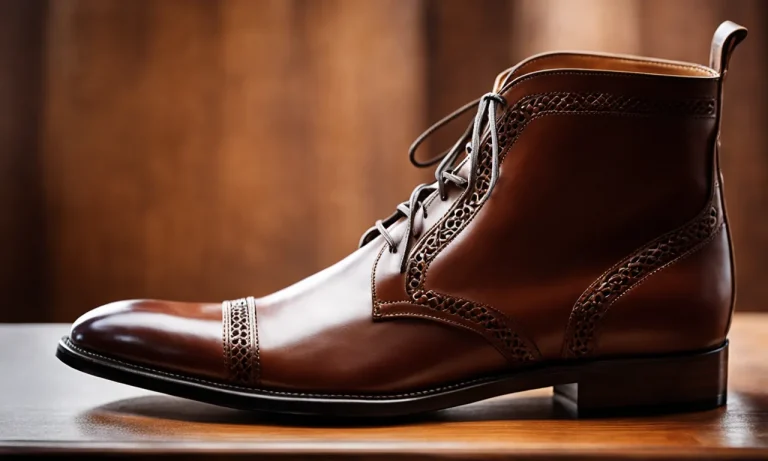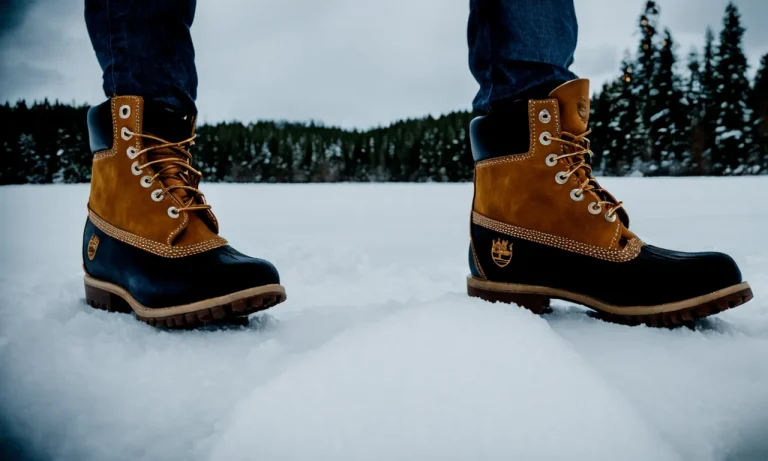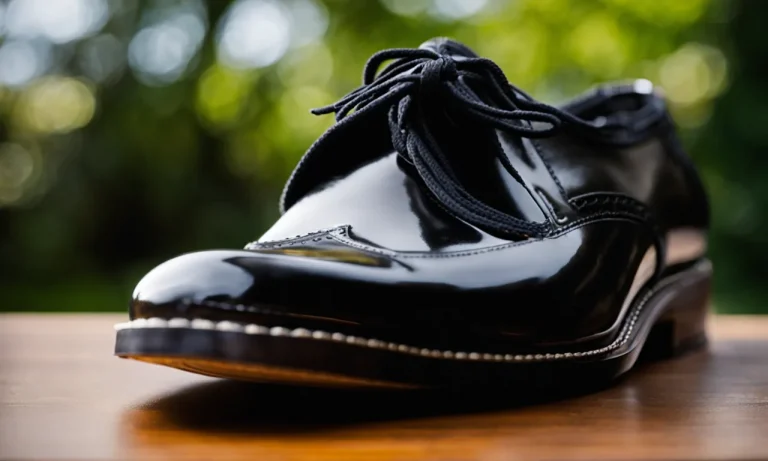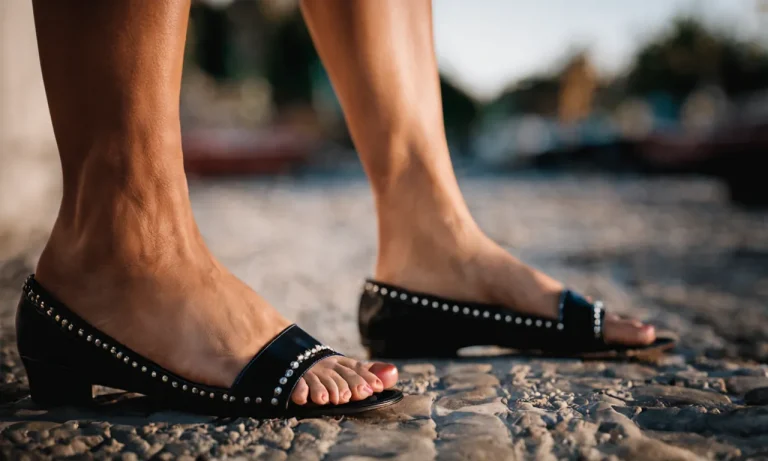If you have ever struggled to fit your foot comfortably into a regular width shoe, you may be wondering – do I need a wide shoe? This is a common question for people with wider than average feet.
If you’re short on time, here’s a quick answer to your question: Most people with wide feet need to size up to a wide width shoe for proper fit and comfort. Wearing shoes that are too narrow can cause pain, blisters, bunions and other foot problems over time.
In this comprehensive guide, we will discuss everything you need to know about wide width sizing for shoes. You’ll learn how to measure your feet properly, understand wide shoe sizing and widths, find the best shoe brands for wide feet, get custom wide shoes, and care for wide width footwear.
What Makes a Foot Wide?
Understanding what makes a foot wide is essential when it comes to finding the right shoe fit. Several factors contribute to foot width, including:
Foot shape and structure
The shape and structure of the foot play a significant role in determining its width. Some individuals naturally have wider feet due to their bone structure or the shape of their arches. For example, people with flat feet often have wider feet since their arches are lower, causing the foot to spread out more.
Weight and pregnancy
Weight gain and pregnancy can also affect foot width. Excess weight can put pressure on the feet, causing them to spread out. Additionally, during pregnancy, hormonal changes can lead to ligament laxity and increased fluid retention, which can result in wider feet.
Health conditions
Certain health conditions, such as arthritis or edema, can cause foot swelling and increase foot width. Arthritis can inflame the joints, leading to foot deformation and wider feet. Edema, on the other hand, refers to the accumulation of fluid in the tissues and can cause temporary foot swelling.
Heredity and ethnicity
Genetics can also play a role in foot width. If your parents or close relatives have wide feet, there is a higher chance that you may inherit this trait. Moreover, studies have shown that foot width can vary among different ethnicities, with some populations having wider feet on average.
It’s important to note that foot width can vary from person to person, and there is no one-size-fits-all answer. If you are unsure about your foot width, it is best to consult with a podiatrist or a shoe fitting specialist who can provide personalized advice based on your specific needs.
Problems Caused by Shoes that are Too Narrow
Wearing shoes that are too narrow can lead to a variety of problems and discomforts. It is important to choose the right shoe width to ensure optimal foot health and comfort. Here are some of the common issues caused by wearing shoes that are too narrow:
Pain and discomfort
One of the most immediate problems of wearing narrow shoes is pain and discomfort. When your feet are squeezed into shoes that are too tight, it can cause pressure points and restrict the natural movement of your feet. This can result in soreness, aching, and overall discomfort throughout the day.
Blisters and calluses
Tight shoes can also lead to the formation of blisters and calluses. When your feet rub against the sides or front of narrow shoes, friction occurs, causing irritation and the development of painful blisters.
Furthermore, calluses can form as a protective response to repeated pressure and friction, leading to hardened and thickened skin.
Bunions and bone deformities
Wearing narrow shoes over a prolonged period can contribute to the development of bunions and bone deformities. Bunions are bony bumps that form on the joint at the base of the big toe. They can be painful and make it difficult to find properly fitting shoes.
Additionally, shoes that are too narrow can cause the toes to become misaligned, leading to other bone and joint issues over time.
Circulation and nerve issues
Shoes that are too narrow can restrict blood flow and cause circulation problems. This can result in numbness, tingling, and even nerve damage in severe cases. Proper circulation is crucial for maintaining healthy feet and preventing issues such as peripheral neuropathy.
It is important to note that the problems mentioned above can affect not only the feet but also other areas of the body, as they can alter your gait and posture. Therefore, it is essential to choose shoes that provide adequate width and allow your feet to move and function naturally.
If you are experiencing any of these issues or have concerns about the width of your shoes, it is recommended to consult with a podiatrist or footwear specialist who can provide guidance and help you find the right shoes for your feet.
How to Measure Your Feet Properly
Use a Brannock device
When it comes to measuring your feet accurately, using a Brannock device is highly recommended. This device is designed specifically for measuring feet and takes into account both length and width. It provides precise measurements, helping you determine the right shoe size for your feet.
You can find a Brannock device at most shoe stores or even online.
Measure at the end of the day when feet are largest
Did you know that our feet tend to swell throughout the day? That’s why it’s important to measure your feet at the end of the day when they are at their largest. This ensures that you get the most accurate measurements for both length and width.
By doing so, you can avoid buying shoes that feel too tight or uncomfortable when your feet are at their maximum size.
Trace your foot on paper
If you don’t have access to a Brannock device, don’t worry! You can still measure your feet at home using a simple method. Grab a piece of paper, place it on a hard surface, and stand on it. Then, trace the outline of your foot using a pen or pencil.
Once you’re done, measure the length from the heel to the longest toe and the width at the widest part of your foot. This DIY method can give you a rough estimate of your foot size.
Consider length and width needs
When it comes to finding the right shoe, it’s not just about the length but also the width. People with wider feet may need to consider wide or extra-wide shoe options to ensure a comfortable fit. Bunched up toes or pinched sides are signs that your shoes are too narrow.
On the other hand, if your shoes feel loose or slide around, they might be too wide. Taking both length and width into account will help you find the perfect fit for your feet.
Remember, proper shoe fit is essential for both comfort and foot health. By following these tips on how to measure your feet properly, you’ll be well on your way to finding the perfect pair of shoes that not only look great but also feel amazing on your feet!
Understanding Wide Shoe Sizing and Widths
When it comes to finding the perfect pair of shoes, having the right fit is crucial. For individuals with wider feet, finding shoes that provide enough room and comfort can be a challenge. That’s where wide shoe sizing and widths come into play.
Understanding the different aspects of wide shoe sizing can help you find the perfect fit and alleviate any discomfort or pain caused by ill-fitting shoes.
Women’s vs Men’s Sizing
Wide shoe sizing differs between men’s and women’s shoes. In general, women’s shoes tend to be narrower than men’s shoes. This means that women with wider feet may have a harder time finding comfortable shoes.
It’s important for women to pay attention to the width of the shoe, in addition to the length, to ensure a proper fit. Men’s shoes, on the other hand, often come in wider sizes, making it easier for men with wider feet to find suitable options.
Width Designations (B, D, 2E, 4E etc.)
Shoe width is usually indicated by a letter, such as B, D, 2E, or 4E. The letter represents the width of the shoe, with B being the narrowest and 4E being the widest. It’s important to note that these designations can vary between brands, so it’s always a good idea to consult the brand’s sizing chart for accurate measurements.
If you’re unsure about your shoe width, it’s recommended to visit a shoe store and have your feet professionally measured.
Sizing Charts by Brand
Many shoe brands provide sizing charts on their websites, which can be a helpful resource when determining your correct shoe size and width. These charts often include measurements for both length and width, allowing you to find the perfect fit.
Some popular shoe brands with comprehensive sizing charts include Nike, New Balance, and ASICS. You can find these sizing charts on their respective websites: https://www.nike.com, https://www.newbalance.com, https://www.asics.com.
Trying on Shoes for Fit
While sizing charts can provide a helpful starting point, trying on shoes is still the best way to determine if they fit properly. When trying on wide shoes, pay attention to how they feel around the toes and the sides of your feet.
There should be enough room for your toes to wiggle comfortably, and the shoe should not feel too tight or constricting. Walk around in the shoes to ensure they don’t rub or cause any discomfort. Remember, everyone’s feet are unique, so what works for one person may not work for another.
Take the time to find the right fit for your individual needs.
Best Shoe Brands for Wide Feet
New Balance
New Balance is renowned for its wide range of shoes that cater to individuals with wider feet. The brand offers a variety of styles and models specifically designed to provide comfort and support for wider foot shapes.
With their innovative technologies and cushioning systems, New Balance shoes ensure a comfortable fit without compromising on style. Whether you’re a runner, walker, or simply looking for everyday footwear, New Balance has a wide selection to choose from.
Saucony
Saucony is another top brand that understands the needs of individuals with wide feet. They offer a wide range of options in various categories, including running shoes, walking shoes, and even casual sneakers.
Saucony shoes are known for their excellent cushioning and stability, providing the necessary support for those with wider feet. Their designs are not only functional but also stylish, making them a popular choice among individuals with wide feet.
Brooks
Brooks is a trusted name in the footwear industry, and their shoes are highly recommended for individuals with wide feet. The brand offers a wide toe box and a roomier fit, ensuring comfort and preventing any discomfort or pain caused by cramped toes.
Brooks shoes are known for their durability and support, making them an excellent choice for runners and athletes with wider feet.
Asics
Asics is a well-known brand that caters to individuals with wide feet. Their shoes are designed to accommodate wider foot shapes while providing the necessary support and stability. Asics offers a wide range of models for various activities, including running, walking, and training.
Their gel cushioning system and breathable materials make their shoes comfortable for long hours of wear. If you have wider feet, consider exploring the options available from Asics.
Altra
Altra is a brand that focuses on creating shoes with a wider toe box and zero-drop platform, making them an ideal choice for individuals with wider feet. Altra shoes are designed to allow your toes to splay naturally, providing a more comfortable and stable fit.
Their shoes are known for their lightweight and responsive nature, making them suitable for running, walking, and everyday wear. If you’re looking for a shoe brand that prioritizes the needs of those with wider feet, Altra is worth considering.
Getting Custom Shoes for Wide Feet
If you have wide feet, finding comfortable and well-fitting shoes can be a challenge. Off-the-shelf shoes often don’t provide enough room or proper support, leading to discomfort and possible foot problems.
However, there are options available to accommodate wide feet, including getting custom-made shoes. In this section, we will explore three popular methods for obtaining custom shoes: custom orthotics, bespoke shoemakers, and 3D printed shoes.
Custom Orthotics
Custom orthotics are specially designed insoles that provide support and cushioning for your feet. They are made to fit the unique shape of your feet, including any width issues. Orthotics can help distribute pressure evenly across your feet, reducing discomfort and preventing foot conditions such as bunions or plantar fasciitis.
To get custom orthotics, you will need to consult with a podiatrist or orthopedic specialist. They will assess your feet and determine the specific needs for your orthotics. Measurements and molds of your feet will be taken to ensure a perfect fit.
Once the orthotics are made, they can be inserted into your existing shoes or incorporated into custom-made shoes for even better comfort.
Bespoke Shoemakers
Bespoke shoemakers are craftsmen who create shoes from scratch, tailored specifically to your feet. They take precise measurements and create a shoe pattern that perfectly matches the shape and width of your feet.
Every aspect of the shoe, from the materials used to the design details, can be customized to your preferences.
Working with a bespoke shoemaker is a unique and personalized experience. You’ll have the opportunity to discuss your needs and style preferences, ensuring that the final product not only fits well but also reflects your individual taste.
While bespoke shoes can be more expensive than off-the-shelf options, the level of craftsmanship and attention to detail is unparalleled.
3D Printed Shoes
Technology has revolutionized the way we create footwear, and 3D printing is no exception. 3D printed shoes are created using computer-aided design (CAD) software and specialized printers that can produce intricate and customized designs.
This method allows for precise adjustments in width, ensuring a perfect fit for wide feet.
With 3D printed shoes, you have the freedom to choose from a variety of materials and styles. The shoes can be lightweight, flexible, and durable, offering both comfort and functionality. Additionally, the production process is more sustainable as it reduces waste and allows for on-demand manufacturing.
It’s important to note that while 3D printed shoes offer customization for wide feet, they may not be as widely available as other options. However, the technology is rapidly advancing, and more companies are starting to offer this innovative solution.
Caring for Your Wide Width Shoes
When you invest in a pair of wide width shoes, it’s essential to take proper care of them to ensure their longevity and maintain their comfort. Here are some tips for caring for your wide width shoes:
Use shoe trees
After wearing your wide width shoes, it’s a good idea to use shoe trees to help maintain their shape. Shoe trees not only help to prevent creasing and wrinkling but also assist in preserving the width of the shoe.
They are particularly useful for leather or suede wide width shoes, as they help to absorb moisture and maintain the material’s integrity.
Apply conditioner
Regularly applying a conditioner specifically designed for the material of your wide width shoes can help keep them soft, supple, and resistant to cracking. For example, leather shoes can benefit from a leather conditioner that nourishes the material and prevents it from drying out.
Conditioning your wide width shoes periodically will not only enhance their appearance but also extend their lifespan.
Avoid over-stressing shoes
Wide width shoes are designed to accommodate wider feet, providing extra room and comfort. However, it’s important to avoid over-stressing the shoes by wearing them in situations that may put excessive strain on the material or structure.
For instance, if you’re engaging in activities that involve a lot of jumping or running, it’s advisable to wear shoes specifically designed for those activities to avoid damaging your wide width shoes.
Replace insoles regularly
The insoles of your wide width shoes can wear out over time, leading to decreased cushioning and support. To maintain optimal comfort, it’s recommended to replace the insoles of your wide width shoes regularly.
This will not only enhance the overall fit of the shoes but also provide better shock absorption and reduce the risk of foot fatigue.
By following these tips, you can ensure that your wide width shoes remain in great condition, providing you with comfortable and stylish footwear for years to come.
Conclusion
Having wide feet is very common, so you are not alone if you need a wider shoe. Wearing proper fitting shoes customized for your foot width will provide the comfort and support you need for happy, healthy feet.
Be sure to get your feet accurately measured, understand sizing charts for width, and don’t hesitate to size up or go to a wide width if needed. Your feet will thank you!
With some brands like New Balance catering specifically to wide sizes, and custom orthotics and bespoke shoemaking available, there are many options to find the perfect wide shoe for your needs. Our comprehensive guide outlines everything you need to know to find wide width footwear that fits well and feels great!






